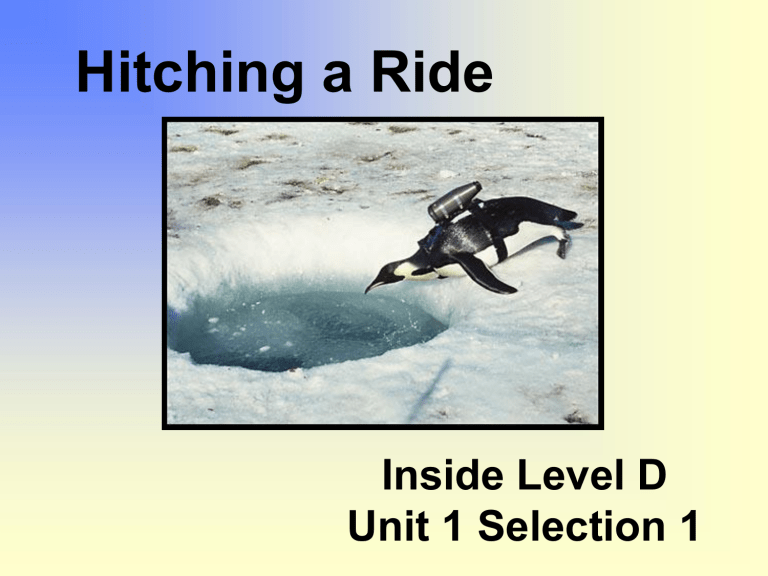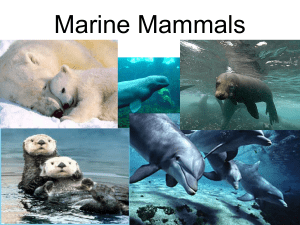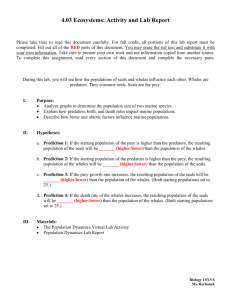Level D Unit 1 - Twin Rivers Unified School District

Hitching a Ride
Inside Level D
Unit 1 Selection 1
On the previous slide you saw a
Crittercam-wearing emperor penguin plunging into a dive hole at the Penguin
Ranch research station in Antarctica.
Crittercam video has shown how some emperors hunt beneath the ice: They swim down deep, look up to see fish silhouetted against the glowing ice, then shoot up to snatch their prey !
What is Crittercam?
National Geographic's Crittercam systems are research instruments worn by wild animals. The systems allow scientists to learn how animals use their habitat, where they feed and how they interact with animals of their own species and of other species. We also learn how they communicate, how they mate, how they move and how they hunt and feed. We can learn how deep marine animals dive and why they stay under water as long as they do.
Crittercams
How was Crittercam invented?
In 1986, while diving off the coast of
Belize, marine biologist Greg
Marshall encountered a shark. The shark approached him, then disappeared with three quick strokes of its tail. Stuck to the shark's belly was a remora fish. As
Greg watched the shark disappear, it occurred to him that if he could put a camera in place of the remora, he could learn about the shark's behavior.
Inspired, Greg built the first Crittercam and deployed it on a sea turtle in
1987. The turtle behaved normally —the first indication that this type of system had potential as a research tool.
What animals have worn Crittercams?
Crittercam has allowed scientists to study more than
50 species of sharks, sea turtles, whales, seals, and penguins. With the development of a terrestrial Crittercam, scientists have begun research programs working with lions, hyenas, and grizzly bears. Scientists have been able to study some biological mysteries, including the following: How do humpback whales hunt together? Why do blue whales call? Where do
Hawaiian monk seals find their food? How do harbor seals stake out territory? How do emperor penguins hunt? Where do sharks stalk their prey?
When do leatherback turtles mate?
Layla is a lioness in Kenya who wears the first
Crittercam built for a wild land animal.
The Hawaiian monk seals have been listed as endangered by the U.S. government. After Crittercam video helped scientists to better understand where
Hawaiian monk seals feed, the government moved to further protect the seals' feeding grounds.
A pilot whale with Crittercam surfaces off the coast of Kona, Hawaii.
Crittercam has shown that pilot whales dive together to depths of over 650 feet (200 meters) and that they are social at these depths
How do you attach Crittercam to an animal?
The method depends on the species.
For whales, dolphins, and leatherback turtles, special suction cups are used.
With seals and hard-shelled turtles a small adhesive patch is used.
Custom-tailored, backpack-like harnesses do the job for penguins.
A fin clamp keeps Crittercam swimming with sharks.
For land animals such as bears, lions, and hyenas, a Crittercam collar is used.
Crittercam
Web Site
Einstein’s Daughters is an all girls robotic team. They have competed in the world wide robotic competition! In January, they received the Inspire Award. This award is given to the team with the best overall robot design, engineering notebook, community outreach, enthusiasm and gracious professionalism.
Einstein Daughters
Six High School Students
Grades 10, 11 and 12
KID INVENTORS DAY
(K.I.D)
January 17
The reason K.I.D.’s Day is January
17 th is because it is Benjamin
Franklin’s birthday – AND, he invented the first swim flippers almost 300 years ago at age 12!
Television.
Water skis.
Earmuffs.
The Popsicle.
What do they have in common?
All were invented by kids!
• 500,000 children and teens invent gadgets and games each year. These innovations help make our lives easier – and more fun!
• Celebrate the ingenuity and value of young brainstormers on KID INVENTORS’ DAY!
Chester Greenwood invented earmuffs at the age of 15 (1873). While testing a new pair of ice skates, he grew frustrated at trying to protect his ears from the bitter cold. After wrapping his head in a scarf, which was too bulky and itchy, he made two ear-shaped loops from wire and asked his grandmother to sew fur on them. That was the beginning of earmuffs!
Six year old Robert Patch invented a "toy truck".
Robert's toy truck was designed to be easily assembled and disassembled by a child and the toy could be changed into different types of trucks each time (ie. closed van style body or dump truck).
Frank Epperson was only 11 years old when he invented the originally named Epsicle. He had left his fruit flavored soda outside on the porch with a stir stick in it. The drink froze to the stick and tasted good. It took 18 more years in 1923 for Epperson to apply for a patent for a "frozen ice on a stick" called the Epsicle Ice Pop, which his children re-named the
Popsicle.
How to Celebrate K.I.D.’s Day
• Read about it.
• Write about it.
• Host an Invention Convention.
• Start a Young Inventors’ Club.
• Enter a contest.
• Keep an invention journal. Or, better yet: design your own invention!
Kid Inventors Video











